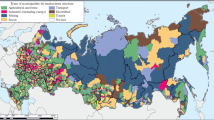Abstract
Knowledge of territorial distribution of population and trends of its change are very important for design of socio-economic development plan for separate regions and for whole countries. In this paper features of territorial distribution of population on settlements in Russia are studied. For study of population territorial distribution the data of all-Russian population census of 2010 are used. In total, an information about 21276 settlements are included on these data. Test with using of Pearson’s criterion of hypothesis about normal distribution law of random variable, which is a decimal logarithm of settlements population size, showed, that such hypothesis must be rejected at significance level α = 0.005. Thus, Gibrat law is not fulfilled for Russian settlements. It is established, that one entrenched system of population territorial distribution by settlements in Russia is absent currently. The largest cities Moscow and Saint Petersburg are developing separately from the rest Russian territories. Excluding Moscow and Saint Petersburg there are up to 26 different clusters of settlements. Within each of such clusters a people distribution by separate settlements is obeyed to Pareto. And Pareto distribution parameters differ from each other in the different clusters. For the largest Russian cities Zipf law does not fulfilled.
Access this chapter
Tax calculation will be finalised at checkout
Purchases are for personal use only
Similar content being viewed by others
References
Andreev, V.V.: Territorial distribution of the population in the Russian Federation. Econ. Reg. 13(3), 803–811 (2017)
Andreev, V.V., Lukiyanova, V.Yu., Kadyshev, E.N.: Analysis of people territorial distribution in regions of the Volga Federal District on the base of Zipf and Gibrat laws. Appl. Econ. 48(4), 97–121 (2017)
Portal of the 2010 All-Russian Census. http://www.gks.ru/free_doc/new_site/perepis2010/croc/perepis_itogi1612.htm. Accessed 11 June 2020
Gibrat, R.: Les Inégalités Économiqués; Applications: Aux Inégalités des Richesses, a la Concentration des Entreprises, Aux Populations des Villes, Aux Statistiques des Familles, etc., d’une Loi Nouvelles, La Loi de l’Effet Proportionnel. Librairie du Recueil Sirey, Paris (1931)
Zipf, G.K.: Human Behavior and the Principle of Least Effort. Addison-Wesley Press, Cambridge (1949)
Eeckhout, J.: Gibrat’s law for (all) cities. Am. Econ. Rev. 94(5), 1429–1451 (2004)
Levy, M.: Gibrat’s law for (all) cities: comment. Am. Econ. Rev. 99(4), 1672–1675 (2009)
Eeckhout, J.: Gibrat’s law for (all) cities: reply. Am. Econ. Rev. 99(4), 1676–1683 (2009)
Berry, B.J.L., Okulicz-Kozaryn, A.: The city size distribution debate: resolution for US urban regions and megalopolitan areas. Cities 29, S17–S23 (2012)
Arshad, S., Hu, S., Ashraf, B.N.: Zipf’s law and city size distribution: a survey of the literature and future research agenda. Physica A Stat. Mech. Appl. 492, 75–92 (2018)
Cristelli, M., Batty, M., Pietronero, L.: There is more than a power law in Zipf. Sci. Rep. 2, 812 (2012)
Devadoss, S., Luckstead, J.: Size distribution of U.S. lower tail cities. Physica A Stat. Mech. Appl. 444, 158–162 (2016)
Luckstead, J., Devadoss, S.: A comparison of city size distributions for China and India from 1950 to 2010. Econ. Lett. 124(2), 290–295 (2014)
Veneri, P.: City size distribution across the OECD: does the definition of cities matter? Comput. Environ. Urban Syst. 59, 86–94 (2016)
Batty, M.: Rank clocks. Nature 444, 592–596 (2006)
Jażdżewska, I.: Spatial and dynamic aspects of the rank-size rule method. Case of an urban settlement in Poland. Comput. Environ. Urban Syst. 62, 199–209 (2017)
Jiang, B., Yin, J., Liu, Q.: Zipf’s law for all the natural cities around the world. Int. J. Geogr. Inf. Sci. 29(3), 498–522 (2015)
Justo, W.R.: Zipf’s law and the Gibrat’s law: what do the facts have to say about the Brazilian cities? J. Financ. Econ. 2(5), 136–144 (2014)
Li, H., Wei, Y.D., Ning, Y.: Spatial and temporal evolution of urban systems in China during rapid urbanization. Sustainability 8, 651–667 (2016)
Pérez-Campuzano, E., Guzmán-Vargas, L., Angulo-Brown, F.: Distributions of city sizes in Mexico during the 20th century. Chaos Solitons Fractals 73, 64–70 (2015)
Rozenfeld, H.D., Rybski, D., Gabaix, X., Makse, H.A.: The area and population of cities: new insights from a different perspective on cities. Am. Econ. Rev. 101(5), 2205–2225 (2011)
Acknowledgments
The reported study was funded by Russian Foundation for Basic Research (RFBR) according to the research project № 19-010-00631.
I express my deep gratitude to the International Program of scientific grants of Russian Institute for Advanced Study (RIAS) of Moscow Pedagogical State University for supporting in 2018 study on project: “Development and progress of mathematical methods for dynamics analysis of socio-economic processes and systems”.
Author information
Authors and Affiliations
Corresponding author
Editor information
Editors and Affiliations
Rights and permissions
Copyright information
© 2020 The Editor(s) (if applicable) and The Author(s), under exclusive license to Springer Nature Switzerland AG
About this paper
Cite this paper
Andreev, V.V. (2020). Features of Territorial Distribution of Population in Russia. In: Silhavy, R., Silhavy, P., Prokopova, Z. (eds) Software Engineering Perspectives in Intelligent Systems. CoMeSySo 2020. Advances in Intelligent Systems and Computing, vol 1295. Springer, Cham. https://doi.org/10.1007/978-3-030-63319-6_50
Download citation
DOI: https://doi.org/10.1007/978-3-030-63319-6_50
Published:
Publisher Name: Springer, Cham
Print ISBN: 978-3-030-63318-9
Online ISBN: 978-3-030-63319-6
eBook Packages: Intelligent Technologies and RoboticsIntelligent Technologies and Robotics (R0)




